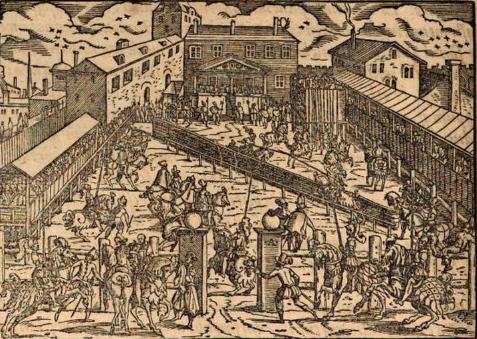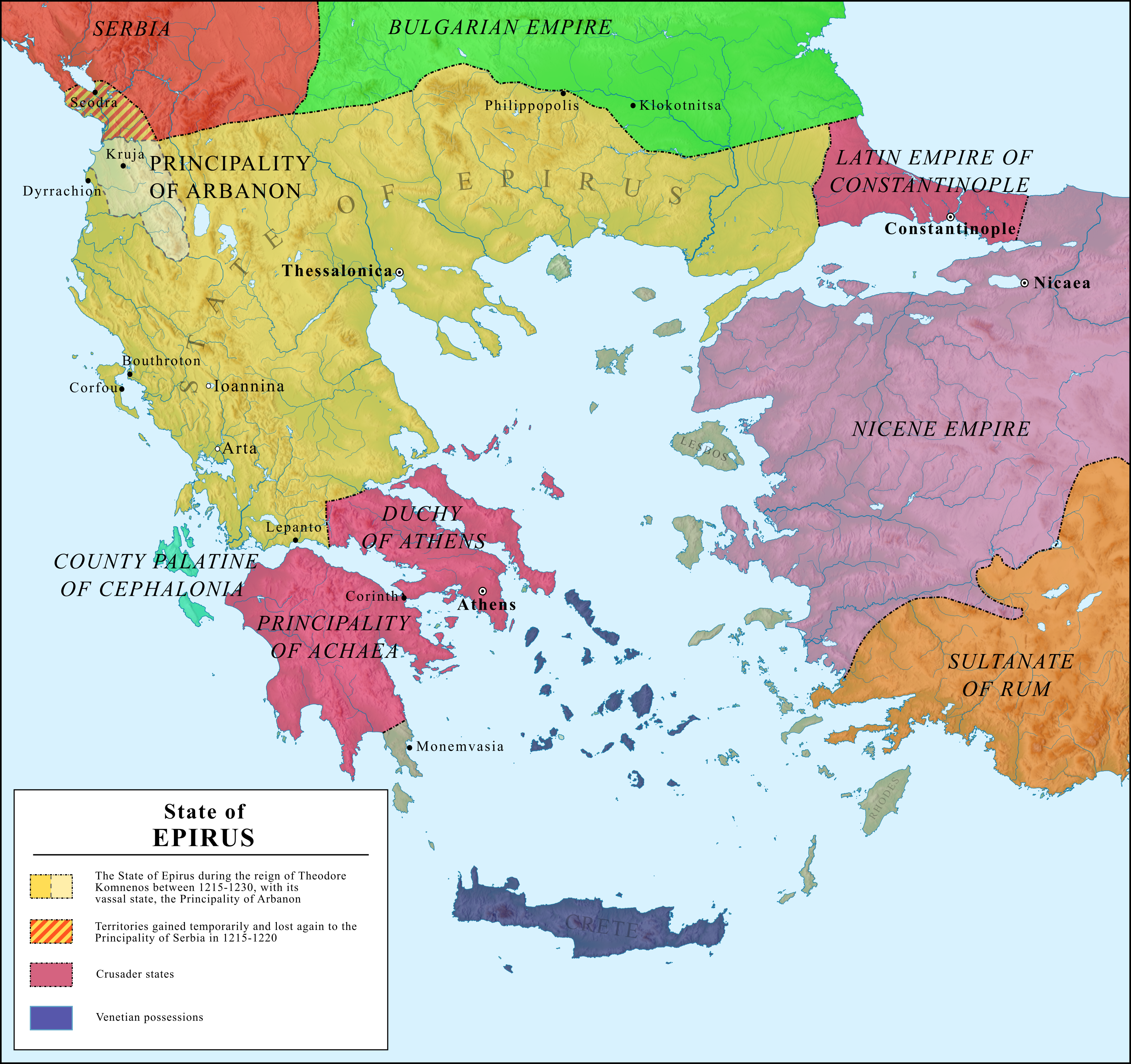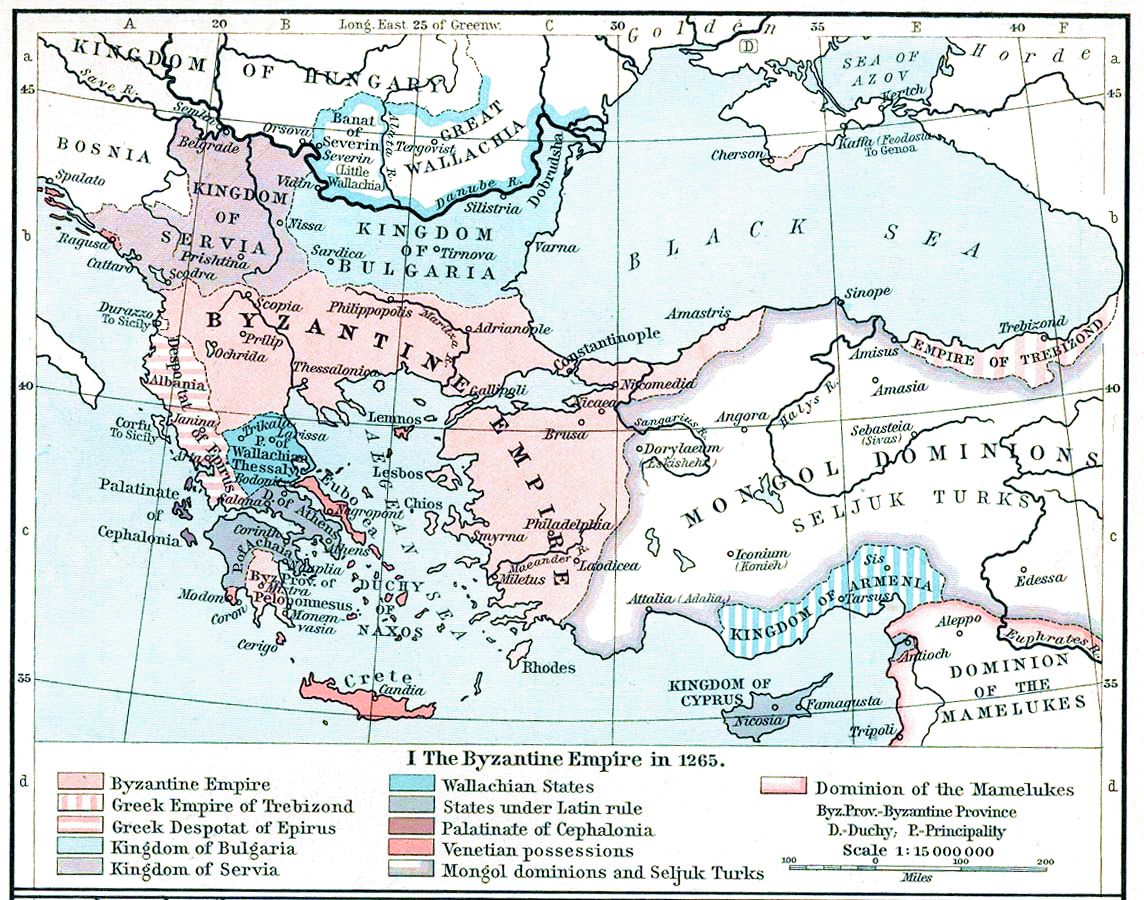|
Krujë
Krujë ( sq-definite, Kruja; see also the etymology section) is a town and a municipality in north-central Albania. Located between Mount Krujë and the Ishëm River, the city is 20 km north of the capital of Albania, Tirana. Krujë was inhabited by the ancient Illyrian tribe of the Albanoi. In 1190 Krujë became the capital of the first Albanian state in the Middle Ages, the Principality of Arbanon. Later it was the capital of the Kingdom of Albania, while in the early 15th century Krujë was conquered by the Ottoman Empire, but then recaptured in 1443 by Skanderbeg, leader of the League of Lezhë, who successfully defended it against three Ottoman sieges until his death in 1468. The Ottomans took control of the town after the fourth siege in 1478, and incorporated it in their territories. A 1906 local revolt against the Ottoman Empire was followed by the 1912 Declaration of Independence of Albania. In the mid-1910s Krujë was one of the battlefields of the conflic ... [...More Info...] [...Related Items...] OR: [Wikipedia] [Google] [Baidu] |
Skanderbeg
Gjergj Kastrioti (17 January 1468), commonly known as Skanderbeg, was an Albanians, Albanian Albanian nobility, feudal lord and military commander who led Skanderbeg's rebellion, a rebellion against the Ottoman Empire in what is today Albania, North Macedonia, Greece, Kosovo, Montenegro, and Serbia. A member of the noble House of Kastrioti, Kastrioti family, Skanderbeg was sent as a hostage to the Ottoman court. He graduated from the Enderun School and entered the service of the Ottoman sultan Murad II () for the next twenty years. His rise through the ranks culminated in his appointment as of the Sanjak of Dibra in 1440. During the Battle of Nish (1443), Battle of Nish in 1443, he deserted the Ottomans and Liberation of Kruja (1443), became the ruler of Krujë and nearby areas extending from Petrelë to Modrič, Struga, Modrič. In March 1444, he established the League of Lezhë, with support from Albanian nobility, local noblemen, and unified the Albanian principalities. In ... [...More Info...] [...Related Items...] OR: [Wikipedia] [Google] [Baidu] |
Skanderbeg Museum
The National History Museum "Gjergj Kastrioti Skënderbeu" (), also known as the Skanderbeg Museum or the Kruja Museum, is located in Krujë and is one of the most important and visited museums in Albania. The museum was built at the end of the 1970s and was inaugurated on November 1, 1982. Its architecture was designed by architects Pirro Vaso and Pranvera Hoxha (the daughter of Enver Hoxha). Construction works were realized by a local team managed by Robert Kote. The museum has the character of a memorial, architecturally inspired by traditional Albanian stone towers and medieval Romanesque architecture. The name of the museum is in the honor of the Albanian national hero Gjergj Kastrioti Skënderbej. The Krujë Castle, which houses the museum, is a historic citadel. Ottoman troops attacked it thrice, in 1450, 1466 and 1467, but failed to take control until a fourth siege in 1476. It was this impregnable fortress that helped George Kastrioti Skanderbeg defend Albania from th ... [...More Info...] [...Related Items...] OR: [Wikipedia] [Google] [Baidu] |
Principality Of Arbanon
Arbanon ( Old Albanian: in Old Gheg, in Old Tosk; ) was a medieval principality in present-day Albania, ruled by the native Progoni family, and the first Albanian state to emerge in recorded history. The principality was established in 1190 by the Albanian ''archon'' Progon in the region surrounding Kruja, to the east and northeast of Venetian territories. Progon was succeeded by his sons Gjin and then Demetrius (Dhimitër), who managed to retain a considerable degree of autonomy from the Byzantine Empire. In 1204, Arbanon attained full, though temporary, political independence, taking advantage of the weakening of Constantinople following its pillage during the Fourth Crusade. However, Arbanon lost its large autonomy c. 1216, when the ruler of Epirus, Michael I Komnenos Doukas, started an invasion northward into Albania and Macedonia, taking Kruja and ending the independence of the principality. From this year, after the death of Demetrius, the last ruler of the Progo ... [...More Info...] [...Related Items...] OR: [Wikipedia] [Google] [Baidu] |
Kingdom Of Albania (medieval)
The Kingdom of Albania (, ) was established by Charles I of Naples, Charles of Anjou in the Albanian territories he conquered from the Byzantine Empire in 1271, with the help of the local Albanian nobility. The Kingdom of Albania was declared in late February 1272. The kingdom extended from the region of Durazzo (Dyrrhachium, modern Durrës) south along the coast to Butrint. A major attempt to advance further in direction of Constantinople failed at the Siege of Berat (1280–1281). A Byzantine counteroffensive soon ensued, which drove the Capetian House of Anjou, Angevins out of the interior by 1281. The Sicilian Vespers further weakened the position of Charles, and the Kingdom was soon reduced by the Byzantine Empire, Byzantines to a small area around Durazzo. The Angevins held out here, however, until 1368, when the city was captured by Karl Thopia. In 1392, Karl Thopia's son surrendered the city to the Republic of Venice. History Background During the conflict between the De ... [...More Info...] [...Related Items...] OR: [Wikipedia] [Google] [Baidu] |
League Of Lezhë
The League of Lezhë (), also commonly referred to as the Albanian League (), was a military and diplomatic alliance of the Albanian aristocracy, created in the city of Lezhë on 2 March 1444. The League of Lezhë is considered the first unified independent Albanian country in the Medieval age, with Skanderbeg as leader of the regional Albanian chieftains and nobles united against the Ottoman Empire. Skanderbeg was proclaimed "Chief of the League of the Albanian People," while Skanderbeg always signed himself as "''Dominus'' ''Albaniae"'' ( Albanian: ''Zot i Arbërisë'', English: ''Lord of Albania''). At the assembly of Lezhë, members from the families Kastrioti, Arianiti, Zaharia, Muzaka, Spani, Thopia, Balsha and Crnojević, which were linked matrilineally or via marriage to the Kastrioti, were present. The members contributed to the league with men and money while maintaining control of the internal affairs of their domains. Soon after its creation, the pro-Vene ... [...More Info...] [...Related Items...] OR: [Wikipedia] [Google] [Baidu] |
Abaz Kupi
Abaz Kupi (6 August 1892 – 17 January 1976; also rendered Abas Kupi) was an Albanian military officer. Kupi was born in Krujë. He served as commander of the gendarmerie of the town of Kruja, and later of the town of Durrës. As a royalist, he created the Legality Movement in Albania, which promoted the return to the throne of Zog of Albania. During the Cold War Kupi was a member of the Free Albania National Committee, which intended to overthrow the communist regime in Albania and to return the monarchy. He was later awarded the Military Order of Bravery (Brave Class). Early life Born on 6 August 1892, in the Varosh neighbourhood of Akçahisar, the Ottoman Empire (now Krujë, Albania). Between 1913 and 1918 he entered the service of Essad Pasha Toptani. In 1922 he took part in the coup d'état of Elez Isufi that attacked Tirana to overthrow the government, but the rebels were defeated by Captain Prenk Pervizi and their soldiers who had come to the aid of Ahmet Zo ... [...More Info...] [...Related Items...] OR: [Wikipedia] [Google] [Baidu] |
Municipalities Of Albania
Municipalities ( or ) are the second-level administrative divisions of Albania, below the counties and above the communes. Since the most recent administrative reforms in 2014, Albania has 61 municipalities. History Municipalities are considered the basic administrative division of Albania. Since its Declaration of Independence from the Ottoman Empire in 1912, Albania has reorganized internal administration 21 times. From independence until the year 2000, regional government was organized into regions () of varying numbers, size, and importance. They were consolidated into groups comprising 12 counties in 1991. Following the 1998 constitutional reforms, the 36 regions of the time were abolished entirely and replaced by the larger counties and two kinds of municipalities: urban municipalities () and rural ones (). In 2014, this was revised to reduce the number of urban municipalities to 61 and extended their jurisdiction over the surrounding countryside to create region ... [...More Info...] [...Related Items...] OR: [Wikipedia] [Google] [Baidu] |
Albania
Albania ( ; or ), officially the Republic of Albania (), is a country in Southeast Europe. It is located in the Balkans, on the Adriatic Sea, Adriatic and Ionian Seas within the Mediterranean Sea, and shares land borders with Montenegro to the northwest, Kosovo to the northeast, North Macedonia to the east and Greece to the south. With an area of , it has a varied range of climatic, geological, hydrological and morphological conditions. Albania's landscapes range from rugged snow-capped mountains in the Accursed Mountains, Albanian Alps and the Korab, Central Mountain Range, Albania#Skanderbeg Mountains, Skanderbeg, Pindus and Ceraunian Mountains, to fertile lowland plains extending from the Albanian Adriatic Sea Coast, Adriatic and Albanian Ionian Sea Coast, Ionian seacoasts. Tirana is the capital and largest city in the country, followed by Durrës, Vlorë, and Shkodër. Albania was inhabited by several List of Illyrian peoples and tribes, Illyrian tribes, among them the A ... [...More Info...] [...Related Items...] OR: [Wikipedia] [Google] [Baidu] |
Tirana
Tirana ( , ; ) is the capital and List of cities and towns in Albania, largest city of Albania. It is located in the centre of the country, enclosed by mountains and hills, with Dajti rising to the east and a slight valley to the northwest overlooking the Adriatic Sea in the distance. It is among the wettest and sunniest cities in Europe, with 2,544 hours of sun per year. Tirana was founded in 1614 by Ottoman Albanian general Sulejman Bargjini, Sylejman Pasha Bargjini, centered on the Sulejman Pasha Mosque, Old Mosque and ''Sulejman Pasha Tomb, türbe''. The city was fairly unimportant until the 20th century, when the Congress of Lushnjë proclaimed it as Albania's capital after the Albanian Declaration of Independence in 1912. The site of present-day Tirana has been continuously inhabited since the Iron Age and was likely the core of the Illyrian kingdom of the Taulantii, which in classical antiquity was centred in the hinterland of Durrës, Epidamnus. Following the Illyrian ... [...More Info...] [...Related Items...] OR: [Wikipedia] [Google] [Baidu] |
Albanoi
The Albanoi (also Albani; , ''Albanoi''; ) were an Illyrian tribe. They were possibly first mentioned by Hecataeus of Miletus (550-476 BCE) under the name '' Abroi''. Ptolemy (100–170 CE) is the first author who mentions them under the name ''Albanoi''. Their central settlement was called '' Albanopolis'' () and was located roughly between the Mat and Shkumbin rivers, in central Albania. The archaeological site of Zgërdhesh has been identified as the likely location of Albanopolis. Stephanus of Byzantium who reproduced Hecataeus added an entry for another settlement named ''Arbon'' in Illyria whose inhabitants were called ''Arbonioi'' or ''Arbonites''. Another ''Arbon'' was recorded by Polybius. John of Nikiû wrote in the 7th century CE about a people known as ''Arbanitai'' in the Greek translation of the manuscript. In the Middle Ages, the names ''Albanoi'' and ''Arbanitai/Albanitai'' referred to medieval Albanians as an ethnic group. The equivalent terms in Latin are ' ... [...More Info...] [...Related Items...] OR: [Wikipedia] [Google] [Baidu] |
Albanian Declaration Of Independence
The Albanian Declaration of Independence (Albanian language, Albanian: ''Deklarata e Pavarësisë'') was the declaration of independence of Albania from the Ottoman Empire. Independent Albania was proclaimed in Vlorë on 28 November 1912. Six days later the Assembly of Vlorë formed the first Government of Albania which was led by Ismail Qemali and the Council of Elders (Pleqnia). The success of the Albanian revolt of 1912, Albanian Revolt of 1912 sent a strong signal to the neighboring countries that the Ottoman Empire was weak. The Kingdom of Serbia opposed the plan for an Albanian Vilayet, preferring a partition of the European territory of the Ottoman Empire among the four Balkan League, Balkan allies. Balkan allies planned the partition of the European territory of the Ottoman Empire among them and in the meantime the territory conquered during First Balkan War was agreed to have status of the Condominium (international law), Condominium. That was the reason for Qemali to or ... [...More Info...] [...Related Items...] OR: [Wikipedia] [Google] [Baidu] |







